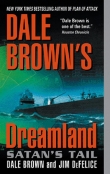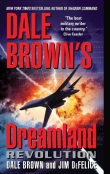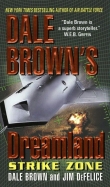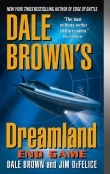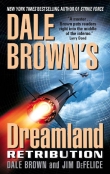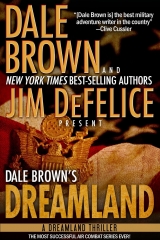
Текст книги "Dreamland"
Автор книги: Dale Brown
Жанр:
Боевики
сообщить о нарушении
Текущая страница: 4 (всего у книги 21 страниц)
“That’s a good way to run things,” said Zen.
“As for your relationship—marriage—to my daughter,” added the colonel, his voice regaining its formal tone, “that’s not my concern. And it should never be. You’re no different than any other officer on this base.”
“Fair enough.”
Zen began wheeling himself backward, swinging around to pull open the door.
The colonel beat him to it. Zen felt his face flush red as Bastian reached past him and opened it for him. He bit his teeth together and rolled on.
* * *
“FORT TWO, MOVE TO LINE ONE, AWAIT FURTHER instructions.”
Breanna acknowledged the controller’s transmission. She leaned against the left window of the big Megafortress, peering down past the plane’s drooping SST-style nose to give her crew chief the thumbs-up. Then she eased back in her seat, adjusted the headset’s microphone, and eased the big jet forward from its parking spot in front of the hangar entrance. One of three Megafortress test beds currently active at Dreamland, Fort Two had started life as a B-52H, the last production model of the Stratofortress. The enhanced B-52, also known as the EB-52, was a pet project of General Brad Elliott, the past commander of Dreamland, who envisioned it as a relatively low-cost, high-capability twenty-first-century flying battleship. The first Megafortress had become famous as “Old Dog,” aka Dog Zero-One Fox; it had at least arguably prevented World War III with a still highly classified preemptive strike on a Soviet laser system some years before. While various EB-52 scenarios had been proposed as production models, the Megafortress concept had never quite made it to permanent funding, losing out to “sexier”—and much more expensive—projects like the B-2.
Each of the three Megafortresses currently flying at Dreamland was configured differently, with different power plants, avionics, and weapons systems. Three more B-52’s, including one older G model, were being converted. All made use of the same basic skeleton: a carbon-titanium hull and remodeled bismaleimide (BMI) resin wings. All were considerably more capable than the admittedly versatile and robust design Boeing engineers had drawn up nearly fifty years before.
Breanna nudged her rudder pedal, gently pushing the plane to the right. Fort Two’s controls were “fly-by-wire”; instead of hydraulics, the control surfaces were moved by small motors directed by electronic impulses in the pedals and yoke. The system was still being perfected, and a hydraulic backup system could be selected by throwing a manual override switch near the throttle panel. Many of Fort Two’s recent experiments involved the control system’s interface with an advanced flight computer capable of flying the plane on its own through a complicated mission set. The engineers were also debating whether traditional controls—such as the yoke that looked like a sawed-off steering wheel—or more contemporary ones like fighter jet sidesticks were better. Fort Two’s control set aimed to meld some of the originals with new technology; when Breanna pulled back on the yoke, it would at least theoretically feel as if she were pulling back on the wheel of a stock model H.
Besides the control systems, Fort Two was testing uprated P&W JT9D-7Rxx2 engines. The power plants allowed for greater speed and less fuel consumption; their increased thrust allowed the designers to replace the B-52’s stock eight power plants with four. That took a bit of getting used to; the new engine set was not only more powerful but considerably quieter. If the Xs—as the engines were called—were adopted as standard, the EB-52 would probably rate as the quietest warplane ever.
“Electric panel one, green,” said the copilot, Captain Chris Ferris. Ferris proceeded through the preflight checklist projected on one of his three multi-use displays. “Two, green. Three, green. Four, green. Crosswind crab.”
“Zeroed,” said Breanna, reading her own tube. The computer was doing the work she would have done in testing and adjusting the equipment in a stock B-52.
“We have pitot heat. We have instruments in the green. We have computers making pilot and copilot completely redundant,” joked Chris.
“As it should be,” groused Dr. Ray Rubeo, one of their two flight deck “tourists.” In rebuilding Fort Two, the forward deck had been stretched and revamped, allowing two large stations to be added immediately aft of the pilot and copilot seats. The walls on either side of the cockpit near the stations featured double banks of video monitors tied to test and monitoring equipment. Rubeo was sitting at station one; Steven McCormick, a somewhat reserved computer scientist, sat at the other.
Chris laughed, continuing through the list of systems that were ready to go. Breanna told the two passengers on the radar-navigation deck below—Greasy Hands and a staff sergeant from the motor pool—that they were proceeding to the runway.
“We’ll take off, do a low-slow circuit of the range, then we’ll have some fun,” she told them over the interphone system, which could be piped to everyone on the plane.
Once manpower-intensive functions, radar and navigation were now handled completely by Fort Two’s prototype flight computer; even the weapons operators, whose “office” was located behind the flight deck just forward of the wing area, were redundant. On Fort Two their panels had been replaced by banks of computers and test circuitry. Had the Megafortress been an active warplane, it would have required only pilot and copilot to complete its mission, though a defensive weapons specialist and a navigator would be preferred additions until all the flight computer systems were at production status. In some ways, Breanna liked the old B-52’s better, with their six-member overworked crews. But this was no time for nostalgia; the tower gave her final clearance as she slipped up to the end of the runway.
“Takeoff power,” she told the flight computer. She glanced at the four-pronged throttle bar, which replaced the multi-fingered mechanical control. Responding to her voice command, the throttle slid into position, thrust precisely and automatically calculated to match not only the plane’s present weight, but the runway and weather conditions. The Xs rumbled on the wings, ready to boogie. “Noisy things,” groused Rubeo.
“Flaps. Optimum takeoff configuration. Go,” Breanna told the computer as she manually released the brakes. They started down the runway, quickly picking up speed.
“Seventy knots, eighty,” read the copilot.
The wings strained at the top of the plane, anxious to lift her into the sky. Breanna nudged her left rudder pedal ever so slightly, keeping the plane centered on the runway as she pulled back on the stick. Depending on its weight and configuration, a standard B-52 might get off the ground in three thousand meters or so; Fort Two lifted off cleanly at just over a thousand, not even breaking a sweat.
“Gear up,” Bree told the computer.
“Gear up and safe,” reported the computer as the giant wheel assemblies folded into the undercarriage.
Breanna checked her altitude, speed, and bearing in the HUD screen. The control system responded instantly to the optical-servers in the yoke housing as she entered a right bank. Whether flying at shoelace level or over fifty thousand feet, dodging enemy fighters or out for a pleasure cruise, the flight computer automatically trimmed the plane’s control surfaces for the most efficient flight regime, essentially reading the pilot’s mind—or rather, her hands and feet.
Breanna glanced back at Rubeo as the plane climbed easily upward. “Okay, Doc, change places with Chris.”
“Why?”
“Come on. You can’t see anything from there.”
“You’re not afraid of flying, are you, Ray?” asked the copilot.
Rubeo narrowed his eyes into a glare; he hated to be called Ray.
“Any monkey can fly,” he said as Chris eased out from behind the copilot’s station. Still, Rubeo hesitated, and Breanna realized that Chris was right. Rubeo was the senior scientist at the base, personally responsible for nearly fifty breakthroughs so secret they couldn’t be openly patented. His work on logic chips was critical not only for their flight computers, but for the actuators used by the Megafortress’s control surfaces. But it turned out he was petrified of flying.
Not that he would admit it. He frowned deeply as he sat down next to her.
“You might want to hitch up the restraints,” she suggested.
“I intend on it,” said Rubeo.
She noticed a definite green tint around his gills. Breanna hit the mike button, switching on the intercom circuit.
“Good morning, and thank you for choosing Dreamland Airlines,” she said. “I’m Captain Breanna ‘Rap for Rapture’ Stockard and I’ll be your tour guide this morning. I have to ask you to remain in your restraints at all times, and please, keep your hands inside the cars. We will be moving at close to the speed of sound, and I’d hate for anyone to lose their jewelry.”
“Yuk, yuk,” mouthed Rubeo.
“On a serious note,” Bree continued, “I would remind you that we are an experimental aircraft. Our systems are held together by bubble gum and duct tape. I do expect that you will remain strapped to your parachutes and snug your skull buckets. You too, Sergeant Parsons.”
“Don’t worry about me, Captain,” answered Greasy Hands.
“If you look out the port windows, you’ll see the Z27 test range, where our friends in the Army are testing their new pulse antimissile system.” Breanna tweaked the control stick, ducking the plane to its left. “Whoa,” she joked. “Don’t everybody look out the windows at once.”
“Very funny,” said Rubeo. His voice was an octave higher than before.
Breanna smirked, launching into a tour-guide dissertation on the history of the venerable B-52. Though she tried to make it sound spontaneous, it was a well-practiced speech; she had given it four times over the past few weeks to Air Force VIPs as part of the effort to keep the Megafortress program alive.
“The B-52 is sometimes called the BUFF—for big, ugly, fat uh, fella, shall we say?” Breanna chortled, knowing everyone would laugh at the obligatory joke. “As a matter of record, the base plane for Fort Two is older than—hell, it’s older than our copilot, Dr. Ray.”
Rubeo ignored her, staring straight out the front windscreen.
“In June 1946,” continued Breanna, “the U.S. government awarded the Boeing company a study contract for a long-range bomber. That seemingly innocuous event led to the design of a turboprop-powered behemoth superficially similar to the B-50, which had evolved from the B-29. You don’t have to have one of Dr. Ray’s four Ph.D.s to realize that a lumbering turboprop would have been no match for the interceptors under development at the time, let alone surface-to-air missiles. The problem was primarily the engines; even optimally engineered turboprops can only turn so fast, as our Communist friends found out with their Tu-95 Bear. But at the time, pure jet engines were equally unacceptable; they were thirsty things in the mid-1940’s, not very powerful and, as Greasy Hands might put it, ‘tarnation and hell’ to work on.”
“Damn straight,” said Greasy Hands.
Breanna thought he might be speaking from experience.
“It was just about that time when the wizards at Pratt & Whitney came up with the J57 jet engine. It was a V-8 for airplanes, capable of delivering 7,500 pounds of thrust without popping a gasket. An Air Force officer looked at the Boeing turboprop proposal one cold Thursday in October 1948 and declared it obsolete. Then he showed the team the specs for the P&Ws and sent them away. They called the next morning from their hotel and promised he’d have a design on his desk Monday. The engineers worked like demons, even building a balsa-wood model. When Monday rolled around, they had invented history’s longest flying bomber, arguably the most versatile and successful military aircraft ever conceived. Through 774 iterations, encompassing eight major families and an almost unfathomable number of alterations and updates, the B-52 has served for nearly fifty years as America’s primary manned strategic bomber.”
“Jeez, it is older than Dr. Ray,” said the staff sergeant sitting with Parsons below.
“Hardy, har, har,” answered Rubeo.
His response got a better laugh than the original line.
Breanna checked her flight position on the global positioning system—accurate to within half a centimeter—then did a quick scan of the vital information on the flight monitor on the right side of her dash before continuing with her historical narrative.
“Now where was I?” she said. “Oh, yes. I should probably note that our new power plants are derived from the engines used by the Boeing 767. They feature considerably more thrust, so much so that Fort Two is currently fitted with one at each engine root instead of the original pair. If my math is correct, that’s four instead of eight. Even so, Fort Two has broken the sound barrier in level flight at 55,000 feet.”
That was an incredibly impressive statistic, since it was impossible for even a “clean” B-52 with minimal load and stock power plants.
“We are, as you may know, testing several engine configurations for the Megafortress,” she continued. “Fort Two is presently the only one with the Xs. And one of our planes—Raven, which we’ve used for ECM tests and Flighthawk drops—still has the original P&Ws. Needless to say, these power plants are better, increasing the plane’s already prodigious range to slightly over ten thousand miles—though most of that’s downhill.”
No one laughed. Tough crowd.
“The B-52 was at least theoretically obsolete by the 1960’s,” said Breanna. “The sheer size of the plane, once dictated by the thirst of the engines, had become as much a liability as an asset. On the other hand, its large size meant we could keep piling equipment on, increasing its life as well as capability. The add-ons and alterations made a not particularly pretty plane one ugly MF, as the saying goes. But the BUFF was—is, I should say—one versatile airframe. You can’t hot-stick her—or at least, we’re not supposed to hot-stick her. But let me tell you something: If you’re beneath the bomb bay when it opens—well, fresh underwear is the least of your problems.”
“Hear, hear,” snarled Rubeo.
“She takes a lickin’ and keeps on tickin’,” said Chris, obviously annoyed by the scientist’s disdain. “I have a picture somewhere of a B-52H model landing without her stabilizer. Try that in a Bone.”
“Bone”—from B-One—was the nickname for the B-1B, also known as the Excalibur and Lancer. Ferris had served with a B-1 squadron before coming to Dreamland.
“Don’t get me wrong,” Chris added. “I love the B-1B. There’s no better low-level penetrator in the world. Mach 9 at five hundred feet wakes you up, let me tell you.”
“Humph,” said Rubeo.
“Much of the technology we’re testing,” continued Breanna sharply, “represents the next wave of development beyond the B-1B and the B-2. Our resin wings, for example, are lighter than those of the B-2. The avionics and control suite that we are currently working on, when perfected, may be used in upgrades to the B-2 or perhaps whatever its successor will be.”
“We know all that,” hissed Rubeo.
Annoyed by the scientist, Breanna punched the plane into a roll.
“And as you can see, the physical improvements to the control surfaces, as well as the reinforcements to the skeleton, make Fort Two as maneuverable as a late-teen fighter.”
“Whoa!” yelled McCormick as Breanna put the plane back on its keel. “Better than a roller coaster.”
“Now I’m not saying a B-52 couldn’t have done that,” Breanna told the passengers as they settled down. “But there’s really no comparison between the two airplanes’ fight profiles. I could demonstrate spin recovery, for example,” she added pointedly, glancing over at her erstwhile copilot.
Rubeo had his hands wrapped around his neck, obviously trying to choke the bile back down.
“But maybe I’ll wait for another time,” Breanna said.
The words were barely out of her mouth when the plane fell out from under her in an uncontrolled, full-power dive.
DOG OPENED THE SIDE DOOR INTO HIS OFFICE AND stepped back fifteen years. Instead of lunch, Patrick McLanahan was sitting on the edge of his desk, wearing civilian clothes and a smile nearly as wide as his shoulders.
“Dog, how the hell are you?” said McLanahan with a laugh. “You’re damn lucky you’re not sitting in a pilot’s seat right now, or your fanny would be waxed solid.”
“I’d just hand the controls over to you and expect to have my butt saved,” replied Dog with a laugh, grabbing his long-ago radar operator in a bear hug. “How the hell are you, Patrick?”
“Still kicking,” said McLanahan. “Despite rumors to the contrary.”
“I’ll bet,” said Dog. McLanahan had been the senior Air Force officer on the DreamStar project, and one of the heads that had rolled after the debacle.
Supposedly. He was looking awful cheerful for someone who’d recently been forced into retirement. And downright natty, with a leather jacket, sharp chinos, and expensive-looking cowboy boots.
Not to mention the fact that his shirt was tucked in.
Obviously something was up. McLanahan may have been the best bombardier in the Air Force, but he had also arguably been the worst dressed, a walking catalog of Reg. 35-10 dress and appearance violations.
“Civilian life agrees with you, I guess,” said Bastian. “In a way.”
“You want some lunch?” Dog asked.
“Sounds good,” said McLanahan.
“You here on business?”
“In a way.”
Dog stuck his head out the door. “I’m going over to find some lunch,” he told Ax.
“They’re waiting for you in the base commander’s lounge at the end of Level B. I’ve rearranged your afternoon. You’re free until 1400.”
“Thanks.”
“I expect it will show up in the next fitness review,” said the sergeant.
“I thought you told me there was a new directive requiring self-evaluation only,” retorted the colonel. “How do we get to Level B?”
“I know the way,” McLanahan told him.
Bastian matched his pace as they headed down a long corridor to a set of steel doors. Inside they descended two levels and emerged in a hallway lined with framed photographs of old Air Force fighters. A thick carpet lay on the floor. A wooden door at the end of the hall gave way to a small, well-appointed room with hunter-green walls and heavy drapes. A sergeant and an airman stood at the side of a row of four tables, each outfitted with fresh linens. The place looked like an exclusive D.C. restaurant.
“I’m going to fix this,” Dog said as they sat down.
“How’s that?” asked McLanahan.
Before Bastian could say anything else, the airman swept in and filled their water glasses. The sergeant slipped a stiff piece of cardboard in front of Dog and stepped back.
It was a wine list.
“I hear the Duck Walk by the glass is a good buy,” quipped McLanahan.
“We won’t be having wine, thank you,” said Bastian, handing the card back. “Damn. I can’t believe Brad Elliott stood for this.”
“Well, first of all, General Elliott was a three-star general,” noted McLanahan. He seemed rather amused. “This sort of thing comes with the territory. And second of all, the lounge was used only for VIPs. Congressmen, the Secretary of Defense, important contractors the general had to impress. Otherwise, Brad ate mostly at his desk.”
“Humph.”
“Being a general means being a politician,” said McLanahan.
“Thank God I’m not a general,” said Dog.
“Listen, I’d appreciate it if you didn’t close the place until after lunch. I didn’t get a chance to have breakfast.”
Dog settled back in the chair. He’d known when he accepted the assignment that he was entering a different world than he’d inhabited before—a world of privilege and power. What McLanahan said about the lounge’s use was undoubtedly true. Hell, from what he’d seen back East, this was austere. It was also likely that the facility—and its wine list—had been donated by defense contractors.
But that didn’t mean it was going to survive. Bastian was a lieutenant colonel and would live like one. And so would everyone else. As of tomorrow morning, he decided as he surveyed the room, all “cafeterias”—strike that, all facilities, all mess halls, all lounges, hell, all dormitories and soda machines—would be “all-ranks.” Everyone was equal, military and civilian, officer and enlisted man.
“Dog?”
“What exactly is it that you want, Patrick?”
McLanahan glanced up as the sergeant returned with menus. Dog took the card silently, scanning it quickly.
Roast leg of lamb in a raspberry mustard sauce. Pureed lentils in a sake-cream soup. Pheasant saltimbocca with squid-ink linguine.
Dog looked up at the sergeant. The man’s arms were straight down at his sides, his thumbs circling rapidly around his fingers. His cheeks were purple, but his forehead was white.
“Look,” Dog told him, trying to smile, “can you get me a medium-rare burger with fries?”
“Gladly, sir,” said the sergeant.
“Me too,” said McLanahan, handing the menu back to the sergeant. “Although I have to say that pheasant was tempting.”
“You didn’t set this up with Ax, did you?” Dog asked McLanahan.
McLanahan laughed and shook his head. “I wish I did. Just to see your face.”
“Are you here to lobby for Megafortress or Cheetah?”
“Neither actually,” said McLanahan, his tone instantly serious. “And not DreamStar or ANTARES either. If you want, I’ll tell you anything you want to know about any of the projects I was involved in. But they’re not why I’m here.”
“Megafortress isn’t going to make the cut, Patrick,” said Dog. “As much as I liked what the Old Dog did, and whatever I think of the flying-battleship idea, there’s no support.”
“I’m not here about that,” said McLanahan. “This is all your headache, not mine. I have new ones to deal with.”
“Such as?”
“ISA,” said McLanahan. ISA stood for Intelligence Support Agency, a high-level covert project funded by the CIA and DOD to support “special” actions. Dog knew it well—he had helped develop the briefing papers and the draft intelligence finding that established the organizational framework. ISA operated outside of the normal military command structure, to put it mildly.
“What’s up?” Dog asked.
“ISA is putting together a special strike package. One of the pilots and two of the support personnel on Dreamland’s roster are going to be asked to join. It’s strictly voluntary, but, uh, there have been some back-channel discussions, as I’m sure you would expect.”
“They need my permission?”
“No, but some of the people back East thought you’d want to be in the loop,” said McLanahan carefully. “I was at Nellis and since we know each other, they asked me to give you a heads-up.”
“You’re running ISA?”
“No. I’m more like a consultant. A freelancer,” said McLanahan. “The pilot is Mack Smith.”
“You want the F-119 too?”
Dog hadn’t meant it as a joke, but McLanahan laughed. “Just Smith,” he said. “The 119 can stay in the shed forever as far as I’m concerned. The technical people are listed as specialists in avionics and engines respectively, but their records show they could build planes from scratch.”
While Smith was an arrogant SOB, Colonel Bastian didn’t particularly want to lose him; the fighter jock was the hottest stick on the patch. And he was the senior officer on the JSF.
“It’s about Somalia,” added McLanahan, obviously sensing his reluctance to part with the pilot.
“Oh,” said Dog. He hadn’t seen the intelligence briefings since a few days before leaving Washington, but McLanahan’s tone made it clear that things there had continued to worsen. The Iranian mullahs had been equipping one of the warlords in the eastern African country, apparently with the intention of helping him take over the government. That would allow them to control access to the Red Sea and Suez Canal, as well as the Gulf of Aden—and thereby manipulate the price and flow of oil. Which itself was supposed to be a prelude to their “Greater Islamic League,” a coalition of Middle Eastern countries dedicated to the prospect of giving America a headache.
“ISA is involved with Somalia?” Dog asked.
“ISA is part of a contingency plan.” McLanahan took a sip of his water. “Iran’s warlord will be in charge inside two weeks.”
“Then what happens?”
“Well, maybe nothing. The analysts are all over the place.”
“I wouldn’t count on nothing,” said Dog. “If the mullahs are feeling strong enough, they’ll base the Silkworms they bought from China there. And after that, they’ll move in the new aircraft they’re buying from Russia. Two dozen Su-35’s and the same number of Su-27’s equipped for surface attack could bottle up half the world’s oil fleet within three hours.”
“Oil prices will go to one hundred dollars a barrel,” said McLanahan. “I read your white paper on it. Hard to believe you wrote it a year ago.”
“The Sukhois are good warplanes.”
“CIA says they haven’t been sold.” McLanahan frowned, but it was impossible to tell whether he believed that or not. “They have the Silkworms ready to go. And rumor has it that they’re working with the Chinese on an aircraft carrier, which should be ready within a few months, if not weeks. The NSC is recommending that this thing be cut off quickly. Which is why I—ISA, that is, wants Smith.”
The sergeant emerged from the kitchen pushing a large cart. On top of it were two deluxe burger plates, with oversized hamburgers on grilled potato-bread rolls. Large saucers of ketchup, mustard, and relish flanked a massive heap of steak fries at the side of the plates.
“Now this is what I call first class,” said Dog, thanking the sergeant.
“I would have thought you’d be used to fancy food, having come from Washington,” said McLanahan. “I hear they love you at the White House.”
“I met the President exactly once,” said Dog. “And that was in a room with fifty people.”
The burger was excellent, perfectly charred on the outside and pink on the inside. Maybe not the healthiest lunch, but tasty enough to justify the risk.
“Like I say, the analysts are all over the place on this. We’re not exactly knee-deep in intelligence on what Iran is up to,” McLanahan said, picking up the napkin from his lap and dabbing at the side of his mouth. “Good burger.”
“Very good,” said Dog. “The Iranians have studied the Oil Shock of the seventies. They know what the impact on the Western economies would be of doubling or quadrupling the price of oil. And don’t forget, they’ll benefit from the extra money. They’ll go straight to Russia and lure another fifty or sixty scientists for their nuclear program. As well as plutonium.”
“You sound like you’re still working for Ms. O’Day.” McLanahan picked up one of the large steak fries with his fork. “CIA says they’re at least six years away from a bomb.”
“They’re crazy. More like six months. You should talk to Jack O’Connell.”
“I have,” said McLanahan. O’Connell was a CIA ground officer who’d been in Africa and the Middle East as well as Russia, tracking Russian nuclear technology.
“Is ISA hooked up with Madcap Magician?” asked Bastian.
McLanahan didn’t answer. From what Dog had been told at the NSC, Madcap Magician was an interservice Spec Ops “program” consisting of volunteers from different branches trained to operate as a covert intervention or first-strike force in the Middle East. Different Spec Ops groups—including a small unit at Dreamland under Danny Freah known as Whiplash—were attached as call-up units; they were supposed to be available on twenty-four-hour notice. Madcap Magician itself was so secret that Bastian didn’t know much about it—but he realized from McLanahan’s silence that he had just nailed the connection.
“Obviously, you can have Smith,” said Dog. He held his half-eaten burger and roll in his hand. It was too good; it tempted him to reconsider his “all ranks” decision.
He put the burger down and pushed the plate away. McLanahan looked at him with an expression close to shock.
“What else do you need?” Dog asked.
“Food’s fine.”
“I mean planes. Hell, I’ve got the hottest weapons on the planet here. Cheetah? The Scorpion AMRAAM-Plus? Tell me what you need and it’s yours.”
“Sounds tempting.”
“We’re an important part of the Air Force,” continued Dog. “With the top talent the military and private enterprise can offer. I have a base full of cutting-edge weapons just begging to be used.”
“I used to work here, remember? You sound like you’re making a funding pitch.”
“No. I’m stating a fact. And maybe a pitch. A little pitch,” conceded Dog. “Because if we put some of these high-tech doodads we’re working on here to work, no one will close us down.”
“Those high-tech doodads you’re working on still have bugs in them,” said McLanahan. “Believe me, I know.”
“Nothing’s without risk. If Dreamland’s going to survive—now there’s a white paper you should read,” he added, referring to the report that had led him to this post.
“What makes you think I haven’t?”
Dog stood up. “I have to get back to work, Patrick. Whoever you need, he’s yours. And I’m serious about the planes and weapons. You know more about what Dreamland can offer than I do.”
McLanahan nodded thoughtfully. “Say hi to Rap for me when you see her.”
Dog nodded, then turned and started back for his office.
THE FIRST THING BREANNA THOUGHT AS THE Megafortress slammed downward was: Damn, this is going to screw up the project big-time.
The next thing she thought was: Damn, we have a serious problem here.
The plane didn’t respond to her yoke. Rap commanded the computer to restore full pilot control. As she did, the legends on the heads-up displays, or HUDs, glowed bright and then flashed out.
“Computer, restore pilot control,” Breanna calmly told the computer, but even as the words left her mouth she realized the computer had been taken off-line. Fort Two’s nose was aimed toward the earth. The g’s were piling up; they were pulling four, then five, the pressure increasing exponentially.
“Okay, we’re going to backup hydraulic control,” she said calmly, reaching for the heavy lever to the right of her seat that would kill the fly-by-wire system and bring the backup hydraulics on line. “Chris, change places with Dr. Ray.”

